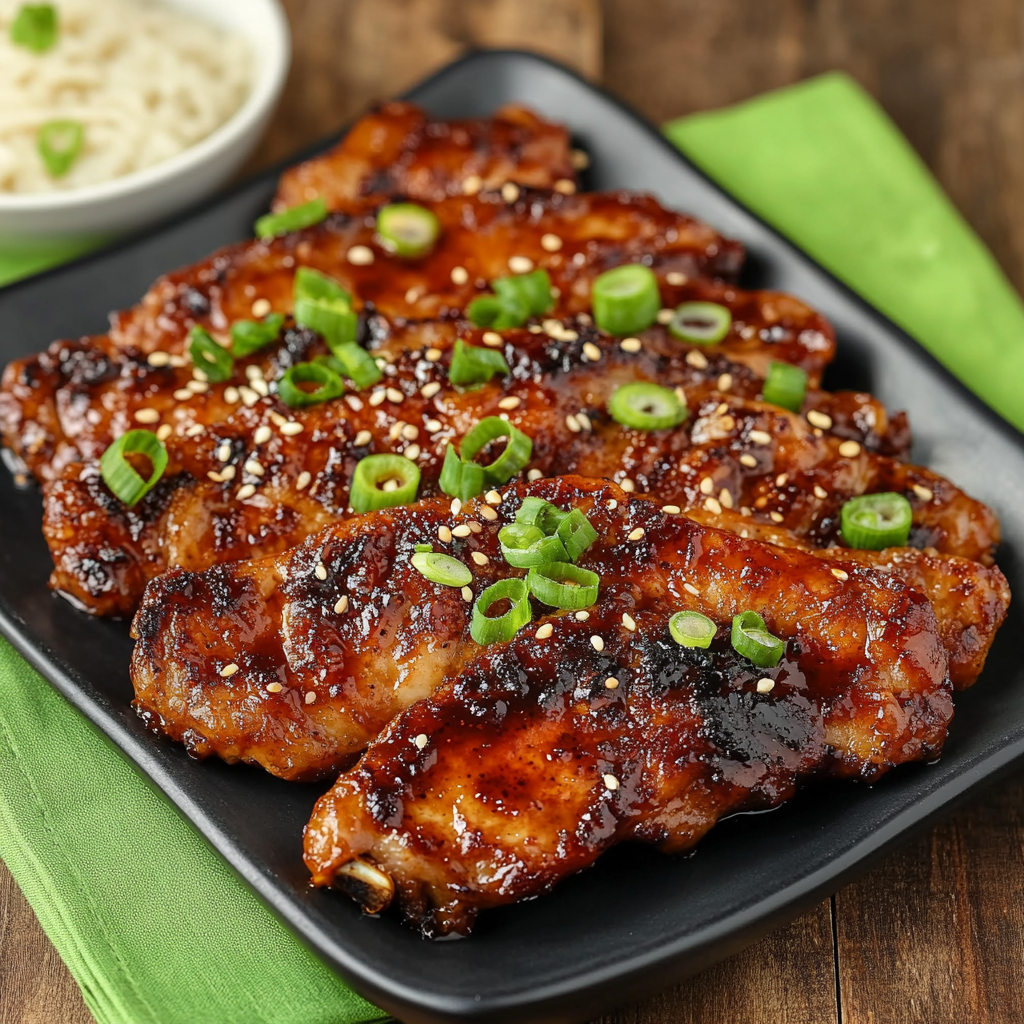Quick Overview
Korean Pork Chops are a delightful addition to your dinner table that brings rich flavors and a satisfying bite. With their tender texture and savory marinade, these chops are perfect for any occasion, whether it is a family gathering or a casual weeknight meal. The combination of sweet and spicy elements in the marinade elevates the taste of the pork, ensuring each bite bursts with flavor. The preparation is straightforward, making it accessible for both novice cooks and seasoned chefs.
This recipe features an authentic blend of ingredients that captures the essence of Korean cuisine without overwhelming your palate. Pair these succulent pork chops with steamed rice or fresh vegetables to create a balanced meal. Follow the simple steps below to whip up a dish that will impress your family and friends and leave them craving more. Get ready to savor the deliciousness of Korean Pork Chops!
Ingredient Breakdown
– Pork Chops (4 pieces): Choose bone-in or boneless pork chops based on your preference. Bone-in chops provide more flavor while boneless are easier to cook evenly.
– Soy Sauce (1/4 cup): This salty ingredient forms the base of the marinade, adding depth to the overall flavor profile.
– Brown Sugar (2 tablespoons): Brown sugar adds sweetness and helps caramelize the exterior during cooking.
– Garlic (3 cloves, minced): Fresh garlic contributes aromatic notes and enhances the savory aspect of the dish.
– Ginger (1 tablespoon, grated): Grated ginger adds warmth and a slight spiciness that complements the savory elements.
– Sesame Oil (1 tablespoon): This oil lends a nutty flavor that is characteristic of many Asian dishes.
– Red Pepper Flakes (1 teaspoon): These provide heat to balance out the sweetness in the marinade.
– Green Onions (for garnish): Chopped green onions add freshness and visual appeal when serving.

Step By step Recipe
1. Prepare the Marinade: In a bowl, combine soy sauce, brown sugar, minced garlic, grated ginger, sesame oil, and red pepper flakes. Whisk until well mixed.
2. Marinate the Pork: Place pork chops in a resealable plastic bag or shallow dish. Pour marinade over them ensuring they are fully coated. Seal or cover and refrigerate for at least 30 minutes or up to 2 hours for deeper flavor.
3. Preheat the Grill or Pan: Heat your grill or skillet over medium-high heat. If using a grill, oil grates lightly; if using a pan, add a touch of sesame oil.
4. Cook the Pork Chops: Remove pork from marinade shaking off excess liquid. Grill or pan-fry for about 5-7 minutes per side until cooked through and internal temperature reaches 145°F.
5. Rest Before Serving: After cooking, let pork chops rest on a plate covered loosely with foil for about 5 minutes. This helps retain juices for maximum tenderness.
6. Garnish and Serve: Slice pork chops as desired and top with chopped green onions before serving alongside rice or vegetables.
Serving and Storing Tips
**Serving Suggestion: **
Serve these Korean Pork Chops hot off the grill with a side of steamed jasmine rice or sautéed vegetables for a complete meal. Adding kimchi or pickled radish can enhance your dining experience by providing contrasting flavors that complement the rich taste of pork.
**Storing Leftovers: **
Store any leftover cooked pork chops in an airtight container in the refrigerator for up to 3 days. To reheat them without drying out, place them in a skillet over medium-low heat covered with a lid until warmed through.
**Freezing Options: **
If you have additional uncooked marinated pork chops left over from your meal prep, consider freezing them before cooking. Place them in freezer-safe bags with excess air removed; they can be frozen for up to 3 months without losing quality.
**Reheating Tips: **
To reheat frozen cooked pork chops effectively, thaw them overnight in the refrigerator before warming them in an oven at 350°F until heated through or use a microwave at medium power checking frequently to avoid overcooking.
Mistakes to avoid
One common mistake when preparing Korean pork chops is not marinating the meat long enough. Marinating infuses the pork with flavor, and if you only let it sit for a short period, you may miss out on that rich taste. Aim for at least 30 minutes, but overnight is ideal for the best results.
Another mistake is using low-quality pork. Cheap cuts can lead to tough and chewy meat. Always choose fresh pork chops from a reputable source. Look for well-marbled cuts, as the fat adds flavor and juiciness during cooking.
Lastly, many people forget to let the meat rest after cooking. This step is crucial because it allows the juices to redistribute within the pork. If you slice into the chops right away, you’ll lose moisture, resulting in dry meat instead of juicy Korean pork chops.
Tips and tricks
To achieve perfectly cooked Korean pork chops, invest in a good meat thermometer. Cooking pork to an internal temperature of 145°F ensures that it is safe to eat while remaining tender and juicy. This simple tool takes the guesswork out of cooking and helps prevent overcooking.
Another tip is to sear the pork chops on high heat initially before lowering it down to medium heat. Searing creates a beautiful crust while locking in moisture. After that, reduce the heat and cook until done, ensuring even cooking throughout.
Don’t forget about side dishes! Pairing your Korean pork chops with traditional sides like kimchi or rice enhances the meal experience. The tangy flavors of kimchi complement the sweetness of Korean barbecue sauce and make for a delightful contrast on your plate.
Suggestions for Korean Pork Chops
For a twist on traditional Korean flavors, consider adding sliced green onions or sesame seeds as toppings when serving your pork chops. These ingredients add freshness and texture that elevate your dish without overwhelming it.
If you’re looking for a spicy kick, try incorporating gochujang (Korean chili paste) into your marinade or sauce. This ingredient brings heat along with a depth of flavor that captures authentic Korean cuisine’s essence.
Finally, serve your Korean pork chops with a refreshing salad made from cucumbers and carrots tossed in rice vinegar. This light dish balances the richness of the pork while providing a crunchy contrast that enhances each bite.

FAQs
What cut of pork is best for Korean pork chops?
The best cut of pork for Korean pork chops is boneless loin or rib chop. These cuts are tender and flavorful, making them perfect for marinating and grilling or pan-searing. The fat content in these cuts also contributes to moisture during cooking.
How long should I marinate Korean pork chops?
Marinating Korean pork chops should last at least 30 minutes, but ideally overnight for maximum flavor infusion. Longer marination allows the ingredients in the marinade to penetrate deeply into the meat, enhancing its taste and tenderness significantly.
Can I use bone-in pork chops instead?
Yes, you can use bone-in pork chops for this recipe! Bone-in cuts often have more flavor due to their fat content and can be just as delicious when prepared properly. Just adjust cooking time slightly as they may take longer to cook through than boneless varieties.
What should I serve with Korean pork chops?
Korean pork chops pair well with various sides like steamed rice, kimchi, pickled vegetables, or Asian-style slaw. These accompaniments help balance flavors while providing contrasting textures that enhance your overall dining experience.
How do I know when my pork chops are done?
The best way to determine if your Korean pork chops are cooked properly is by using a meat thermometer. The internal temperature should reach 145°F for safe consumption while ensuring tenderness remains intact throughout each bite.
Can I grill these Korean pork chops?
Absolutely! Grilling adds a wonderful smoky flavor that complements the marinade beautifully. Just ensure your grill is preheated adequately before placing the marinated pork chops on it for optimal results during cooking.
Summary
In summary, preparing delicious Korean pork chops involves avoiding common mistakes like insufficient marinating time or using low-quality meat. Utilize tools like thermometers for precise cooking and consider creative side dishes that enhance flavors without overshadowing them. With these tips in mind, you’ll create savory meals that impress every time!

